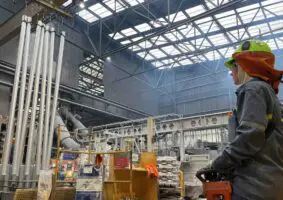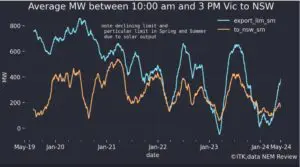AGL Energy’s future in gas is problematic. However, for thermal electricity the position over the next couple of years looks very strong. Only a carbon tax is likely to really weaken that. A very strong increase in renewables investment could put considerable pressure on that outcome, but the impact wouldn’t really be felt before fiscal year 2019 at the earliest.
For AGL the key events over the next few months are:
- What happens to the Portland smelter;
- Getting its renewables fund up and running (QIC is said by the press to be the partner here)
- Coming to a decision about whether and how much to bid for the Alinta assets. The Alinta business is not much connected to AGL’s existing operations and its power station portfolio is not, in our view, attractive to investors with the exception of Braemar. The gas customers in WA are likely a nice stable retail operation.
AGL’s downgrades gas profit outlook in FY17
On Jul 07 AGL announced that:
- Due to (what we think is a QCLNG) safety related shut down, leading to the exercise of something akin to force majeure, and higher output at its Torrens Island gas generator (TIPS), AGL had been forced to buy more gas on the short term market and this was going to cost $35m in the September quarter.
- AGL expects to report consolidated EPS growth in FY17 but expects to report “at least” $100m lower gas profits because of (i) the QCLNG issue and (ii) AGL will earn $1/GJ less in FY17 on 60 PJ of gas sold into the QLD wholesale market. In fact the lower margin on 60 PJ had previously been mentioned in AGL’s presentation to the Macquarie conference.
Comment
Once again this announcement shows how difficult it is for investors to stay in front of the market.
We searched Google in vain for news of the QCLNG/BG/Shell safety related shut down in QLD and any declaration of “force majeure”. There is no such news or declaration.
Essentially investors could not easily have found out that AGL was having to buy gas out of the market to fulfill its supply obligations. QGC will have to fulfill its supply obligation in the future but will not have to compensate AGL for the lossess. This is a typical example of the risks of overhedging. If a generator or in this case gas supplier fails, then the spot price is forced up and the cost of fulfilling the supply contracts is disproportionately increased.
There is also some mild surprise that the margin on the 60 PJ will be lower in FY17 than FY16. Most of that margin is driven by a supply contract between QGC (now part of Shell) that started in 2008 for the supply of 740 PJ over 20 years at an inflation indexed 2008 price of A$2.50 GJ. Since it took some time for QGC to get into production that effectively represents a 2017 price of $3.20 or so and 40 PJ per year.
In short, the cost of that gas won’t change. Subsequently, in 2011 the volume shape of the contract was renegotiated and AGL resold most of the gas back to QGC over a 3 year period that commenced in FY15. The sale back to QGC was at an “attractive oil-linked price”. AGL hedged out the oil risk but we guess the oil related hedging has dropped off and at US$50 oil the price received from QGC will be less than in FY16.
All that said we regard that 40 PJ per year contract as one of AGL’s most valuable assets over the next 10 years. If the market price is say $9 GJ in Sydney netting back to $8 at the well head, and the cost is $4 the contract produces a profit of $160 a year, which at a discount rate of 6% has an NPV of about $08 bn after tax and on 674 m shares is worth $1.22 per share or about 6% of the AGL share price.
Most of the rest of AGL’s QLD supply comes from a contract with APLNG which expires in May 2020 and we estimate the gas in that contract is priced about $4 GJ perhaps $4.50 gj.
AGL sells more than 100 PJ of gas per year as a middle man so as its “backbook” that is gas purchase written at the old gas prices, runs down more of its middle man sales will be at what is effectively oil linked prices from Bass Strait.
AGL’s key profit drivers
After buying Macquarie Generation and following the appointment of a new CEO, AGL has changed its segmental disclosures. Restating segments is a frustrating thing in the financial analyst community. Companies often do it with good reasons but analysts then have to spend days rebuilding models that are typically 1000-2000 rows long in excel.
Our presentation of AGL’s six months to December 2015 compared to December 2014 follows:

The basic driver of AGL is the thermal generation from Loy Yang A in Victoria and the Bayswater and Liddell power stations in NSW. The way we think about this is to look at the total output of the two stations. We then subtract out that part that is dedicated at fixed prices to the Portland aluninium smelter in Victoria and the larger Tomago smelter in NSW. We will return to the smelter contracts shortly.
Broadly speaking after backing out the volumes devoted to those contracts AGL has about 29 TWh of power exposed to the baseload futures price in NSW and Vic.

Every $1 increase in the futures price in NSW and Vic can basically be passed on to customers either in the wholesale market or in the retail market. Since April futures prices are up about $12 MWh in NSW and $11 in Victoria for FY17 and up $8 in NSW and $13! in Victoria for FY18. If these price increase could be fully passed on there would be about $300m pretax upside to AGL in FY17 compared to earlier expectations and more or less compared to FY16 and an increase in FY18 as well.

Eventually, the price increase will be passed on, but we expect AGL like any prudent generator will have hedged some of its output well in advance. We broadly assume that the model is to be 75% hedged 1 year in advance, 50% hedged two years in advance and 25% hedged 3 years out. As such AGL will likely only be able to get some of the FY17 futures price increase as some part of the output will have been hedged before the futures price increasese.
Still in our view the increase when we add in whatever profits are being made on TIPS in South Australia, and they should be useful, should exceed the lower gas margins disclosed by AGL yesterday.
The aluminium contracts
AGL, in theory, can make another $180 m from repriced aluminium conctracts. In Victoria Loy Yang A won the right to supply Portland and Point Henry smelters from LYB (now owned by Energie) some years ago. Point Henry has closed but the new contract with LYA takes effect from November this year. The price of the new contract is undisclosed but we estimate somewhere in the $40-$45 MWh, so actually below the current futures level.
It’s still a substantial increase probably around $10-$15 MWh on what Portland has been paying and we think there is a significant risk that Portland may close. It’s a smelter with no natural competitive advantage in a world of oversupplied aluminium. Two aluminium smelters have already closed in Australia in recent years, Point Henry and Kurri Kurri. A closure of Portland could possibly be arranged to coincide with the closure of Hazelwood if all the ducks could be put in a row leaving LYA in slightly stronger position than today.
In NSW, CSR has announced that the revised contract with Macgen was expected to increase the cost of aluminium by around $230 per metric tonne. The smelter, Australia’s largest, produces about 580 Kt of aluminium per year, so the electricity price increase is about $133 m or about $16 MWh. This will impact AGL in FY8 and FY19. AGL is more or less committed to closing Liddell in 2022 which would offset loss of Tomago volumes should Tomago close but we expect that in the end AGL will negotiate the price increase down if it perceives that Tomago is serious about closing.
David Leitch is principal of ITK. He was formerly a Utility Analyst for leading investment banks over the past 30 years. The views expressed are his own. Please note our new section, Energy Markets, which will include analysis from Leitch on the energy markets and broader energy issues. And also note our live generation widget, and the APVI solar contribution.










